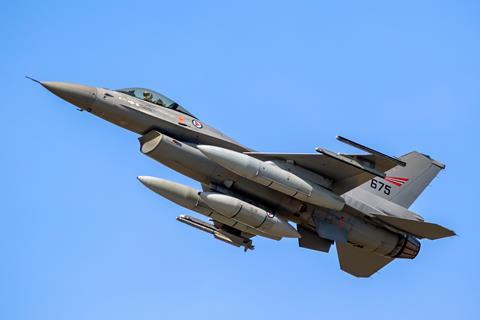In a major policy shift, the US government is now signalling it will support the preliminary stages of providing Ukraine with Lockheed Martin F-16 fighter jets to support the country’s war against invading Russian forces.

The Biden Administration quietly revealed the change on 19 May from Hiroshima, Japan, where US President Joe Biden was attending the G7 summit of world leaders.
“The support has evolved over time, as the war has evolved,” US National Security Council communications coordinator John Kirby said on 20 May. Kirby was speaking on the television programme Today from American broadcaster NBC.
While few substantive details are available, it appears that Washington will not directly supply F-16s to Ukraine. Instead, the USA will support F-16 flight training for Ukrainian pilots, with the expectation that unspecified allied governments in Europe will transfer some of their combat aircraft to Kyiv at a later date.
Ukrainian President Volodymyr Zelensky and his military leaders have been requesting such a transfer for months. Ukraine has called for the formation of a so-called “fighter coalition” to bolster the country’s air force.
“We are inviting the United States to become its most important participant,” Ukrainian prime minister Denys Shmyhal said on 12 April during a visit to Washington DC. “America can once again demonstrate its leadership by providing Ukraine with [Boeing] F-15 or F-16 aircraft.”
The White House and Pentagon have steadfastly, albeit softly, declined such requests, saying the fourth-generation fighters are too difficult to maintain and vulnerable to Russian air defences.
However, administration officials always left open the possibility that stance could change. Speaking from Hiroshima, Kirby denied there has been a substantial policy shift on providing Ukraine with fighter aircraft.
“Nothing has changed,” Kirby says, disputing the appearance of a seemingly seismic shift in Washington’s attitude on the subject. The retired admiral instead characterised the developments as just the latest stage in evolving US support for Ukraine.
Both Kirby and his counterpart at the Pentagon repeatedly stated in recent weeks that the USA had no plans to send fighter aircraft to Ukraine. Just days earlier on 15 May, Pentagon press secretary Brigadier General Pat Ryder said there had been no change in US policy on the matter.
“I don’t have anything to announce today in regards to any type of fighter aircraft,” Kirby notes. “We’re going to stay in very close contact with Ukraine and with our allies and partners to look at both their near term and longer term security needs.”
Washington has preferred instead to provide Ukraine with advanced Western air defence systems, although even that step required prodding from European members of NATO.
Such pressure once again appears to have worn down the sceptics in Washington, although details of the transfer, including where the fighter aircraft will come from, remain unsettled. Discussions on the matter will apparently continue while Ukrainian pilots begin receiving flight training from Kyiv’s supporters.
Russia is responding sternly to the developments, describing the policy change as an “escalation” that carries “enormous risk” in statements to state-owned news agency TASS.
“We can see that Western countries continue to stick to an escalation scenario, which carries enormous risks for them,” Moscow’s deputy foreign minister Alexander Grushko said on 20 May.
Sergey Lavrov, Russia’s top diplomat, says the developments at the G7 summit are part of an attempt at “global domination” by the West.
“The objective was announced loudly and frankly, which is to defeat Russia on the battlefield, and without stopping at this, to eliminate it later as a geopolitical rival,” Lavrov adds.
Russia launched the pre-emptive invasion of its neighbour some 15 months ago, after repeatedly denying the preceding troop build-up on its border with Ukraine was for any purpose other than military drills. Moscow previously seized the Crimean Peninsula from Ukraine in 2014, in another unprovoked attack.
While the USA has provided Ukraine with increasingly advanced and long-range weaponry, Washington has insisted such arms not be used to strike within Russia’s official borders.
Kirby notes that will continue to be the case for any American-made aircraft Kyiv receives.
“We have made it clear that we’re not going to encourage or enable Ukraine to strike inside Russian territory,” he says. Kirby describes the Zelensky government as being “very honest” and “very responsible” in abiding by those terms.
“We’ve had that discussion with the Ukrainians… with respect to fighter aircraft,” Kirby notes. “We’re confident that they’ll live up to their commitments.”


























